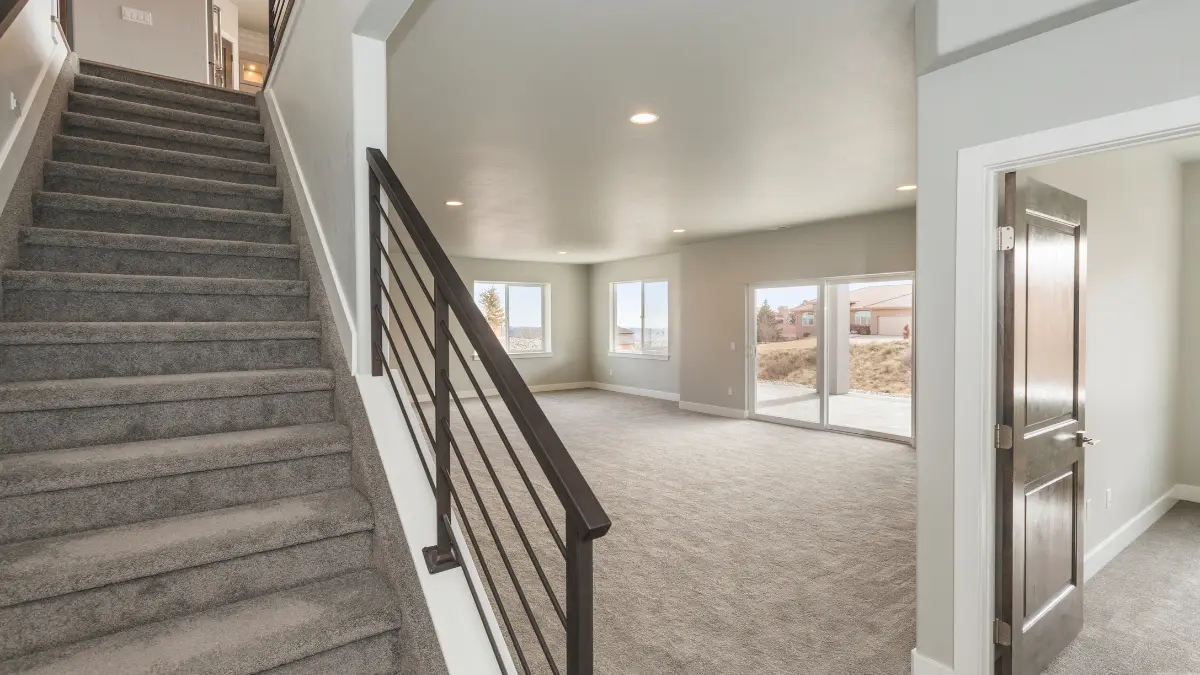Are you considering finishing your basement but wondering if it’s worth the investment? Many homeowners wonder how much value a finished basement will add to their property. Before embarking on any home improvement project, it’s essential to understand the potential return on investment.
Definition of a Finished Basement
A finished basement refers to a lower level of a home transformed into a livable space. Unlike an unfinished basement, which is typically used for storage and houses the principal utilities of a home. A finished basement adds value and functionality to a property.
By converting this below-grade area into a habitable living space. Homeowners can maximize their property’s square footage, creating additional rooms and living areas that meet their needs. Whether it’s a guest bedroom, a home office, a playroom, or a media room, a finished basement offers endless possibilities to expand and enhance the overall living experience of a house.
With proper insulation, ample lighting, and other design elements. A finished basement can become a comfortable and attractive extension of the home’s main living areas. Ultimately, a finished basement adds value in terms of increased square footage and the potential for a higher return on investment when selling the property in a competitive real estate market.
Overview of Benefits of Adding a Finished Basement
Adding a finished basement to your home offers a multitude of benefits. It provides valuable additional living space and allows customization according to your needs and preferences. Whether you envision a cozy home theater, a spacious guest suite, or a recreational area for the whole family, the possibilities are endless.
One of the key advantages of a finished basement is its contribution to improving energy efficiency. By eliminating drafts and adequately insulating the space, a finished basement helps to reduce energy bills and create a more comfortable living environment. This is especially beneficial in regions with extreme weather conditions.
Furthermore, finishing a basement can have significant health benefits. By addressing any moisture issues and adequately sealing the space, you can prevent the growth of mold and mildew. This helps to maintain healthy indoor air quality and reduces the risk of respiratory problems associated with damp environments.
In summary, a finished basement adds value to your home by providing additional living space and the opportunity for customization. It also enhances energy efficiency and promotes a healthier living environment. If you’re looking to optimize the functionality and value of your home, consider investing in a finished basement.
Square Footage Considerations
When considering the value of a finished basement, one critical factor is the additional square footage it provides.
A finished basement adds usable living space to your home. It increases the overall square footage and adds value to your property. This extra space can be utilized in various ways, such as creating a guest bedroom, a home office, a media room, or a play area for children.
The square footage of a finished basement also offers flexibility for future buyers. Especially those who may have specific needs or preferences for their living spaces. Whether adding a workout room, a hobby space, or simply using it as extra storage, the square footage of a finished basement can significantly enhance the functionality and appeal of a home. Moreover, in competitive real estate markets, having a finished basement can give your property an edge over others. Especially as it offers potential buyers more livable space without needing an addition or remodel. So, when considering the value of a finished basement, the square footage it adds is undoubtedly a significant aspect.
Does a Finished Basement Count as Square Feet?
A finished basement is often seen as a valuable addition to a home. It provides extra space that can be used for various purposes. However, it is essential to note that a finished basement does not count as part of the square footage of a home despite being considered as part of the gross living area.
The distinction between a finished basement and above-grade space lies in its location. Square footage calculations only include above-grade or ground-level living spaces. The square footage calculations do not include any space below ground level, such as a finished basement.
When determining a home’s square footage, appraisers and real estate professionals typically consider only the above-grade space. The added livable space in a finished basement does not contribute to the official square footage of the property.
However, it is still essential to consider the value that a finished basement can bring to a home. While it may not impact the official square footage, it does provide additional usable space that can be utilized as a guest bedroom, home office, recreational area, or even a private retreat like a wine cellar. These versatile and functional spaces can significantly enhance a property’s overall appeal and livability.
In summary, a finished basement does not count as square footage regarding the gross living area, as it is not above-grade space. Nonetheless, it still adds value to a home by providing extra functional and usable space.
Does the Added Square Footage Increase the Home’s Value?
Finished basements can significantly increase the value of a home by adding valuable square footage and increasing the livable space. When a basement is finished, it provides additional rooms and entertainment areas that can significantly enhance the functionality and appeal of a property.
The increased square footage of a finished basement can vary depending on the house’s layout. In a two-story home, finishing the basement can increase by up to 50% in livable space. For a bungalow, it can even double the available square footage. This added space opens up a world of possibilities for homeowners.
Having extra rooms and entertainment areas is highly desirable for homeowners. They can use the finished basement as a guest bedroom, home office, playroom, or dedicated entertainment space. This extra space improves the quality of living and allows homeowners to monetize it. They can rent out the basement separately or use it to generate income.
In conclusion, finishing a basement significantly increases the home’s value by providing added square footage and livable space. The versatility and potential for monetization make a finished basement an attractive feature for potential buyers.
How Much Additional Space Can Be Gained by Finishing a Basement?
When it comes to additional space, finishing a basement can significantly expand your home’s livable area. Finishing a basement can increase your living space by up to 50%. Suppose you have a two-story house. In that case, finishing the basement can add an entire floor of extra rooms and entertainment areas.
The possibilities for the use of a finished basement are endless. It can serve as the main entertaining area, complete with a custom-designed bar and cozy seating. Or, you could transform it into a home gym, equipping it with all the necessary fitness equipment. Alternatively, you can create an office space that provides a quiet and productive environment.
If you want to get creative, consider unique additions like a bowling alley or basketball court. The beauty of a finished basement is that it offers flexibility and allows you to tailor it to your specific needs and interests.
By finishing your basement, you unlock a wealth of additional living space that can be utilized in many ways. From expanding your home’s main entertaining area to creating a dedicated gym or office space, a finished basement offers limitless potential to customize and enhance your living environment.
Cost Considerations
When evaluating the value a finished basement adds, it’s essential to consider the cost involved. The average cost of finishing a basement can vary depending on several factors, such as the size and layout of the space, the materials used, and any additional features or amenities desired. However, despite the initial investment, a finished basement can offer a high return on investment (ROI) in terms of monetary value and increased livable space.
In terms of the real estate market, a finished basement can significantly impact the sale price of a home. Potential buyers are often willing to pay more for a property with a finished basement, as it effectively increases the square footage and adds functional living spaces. This extra space can be used for various purposes, such as a guest bedroom, home office, or entertainment area. Additionally, a finished basement with a walk-out or garden-level lot can provide ample natural light and outdoor space, further enhancing its desirability.
When calculating the ROI of a finished basement, it’s essential to consider the potential increase in property value and the functional benefits it provides. While the average ROI can vary depending on the location and quality of the basement finish, it is generally estimated to be around 70-75%. Moreover, having a finished basement can make a property more competitive in a crowded real estate market, attracting more potential buyers.
When properly planned and executed, finishing a basement can be a worthwhile investment, adding significant value to a property and enhancing its appeal in the competitive housing market.
How Much Does it Cost to Finish a Basement?
Several factors come into play when considering the cost of finishing a basement. The type and quality of materials, the desired space, labor rates, permit fees, and furnishings all contribute to the total cost.
According to national averages, finishing a 400 to 1,500-square-foot basement can cost around $21,000. However, it’s important to note that costs can vary significantly, ranging from $3,000 to $80,000, depending on these factors.
The type and quality of materials chosen for the project can significantly impact the final cost. Opting for high-end finishes and fixtures will naturally increase expenses. Labor rates can also vary depending on location and the project’s complexity. Additionally, permit fees may be required, adding to the overall cost.
The desired space within the basement will also influence the price. Creating additional rooms like bedrooms or bathrooms will be more expensive than a simple open-concept design. The type of furnishings and finishes chosen, such as flooring and lighting, will also contribute to the final cost.
Considering these factors, planning, and budgeting is crucial when deciding to finish a basement. By doing so, homeowners can ensure they maximize the value of their investment while creating an inviting and functional living space.
What is the Average Return on Investment (ROI) for Finishing a Basement?
Finishing a basement can be a worthwhile investment for homeowners, as it adds valuable square footage to a home and increases its overall appeal. On average, homeowners can expect an immediate return on investment (ROI) of about 70% of the total cost of finishing a basement. However, it’s important to note that the remaining 30% of the value may be realized over time.
The total cost of finishing a basement can vary depending on several factors. The type and quality of materials chosen for the project, labor rates, and permit fees can all impact the overall expense. For instance, opting for high-end finishes and fixtures will naturally increase costs. Additionally, labor rates can vary depending on the location and complexity of the project.
While homeowners may not recoup the entire investment, having a finished basement can make a home stand out in a competitive real estate market. The added square footage and usable space can be a major selling point for potential buyers. A finished basement can give a property a significant advantage in a market where square footage is often highly sought after.
In conclusion, finishing a basement can provide homeowners with an average ROI of around 70%. While not all of the investment may be recouped, a finished basement’s added value and appeal can make it worthwhile.
Is Finishing a Basement Worth It According to the Real Estate Market?
Finishing a basement can be a significant value-added improvement in the real estate market. A finished basement adds square footage to a home and provides a competitive edge in a competitive market. Potential buyers often seek additional living spaces; a finished basement offers just that.
One key factor contributing to the worth of a finished basement is its versatility. This additional space can be utilized in various ways, such as a guest bedroom, home office, or entertainment area. The potential for customization allows homeowners to tailor the basement to their specific needs and preferences, further increasing its value.
Maximizing return on investment (ROI) is crucial when selling a house with a finished basement. Including the added value of the finished basement in the appraisal process is essential. Do this to ensure the property’s overall worth is accurately assessed. Potential buyers are willing to pay a premium for a home with a finished basement, making it a worthwhile investment for homeowners.
In conclusion, finishing a basement is worth it, according to the real estate market. It adds value to a home and provides a competitive edge by offering additional living space highly sought by potential buyers. By maximizing ROI and including the value of the finished basement in the appraisal process. Homeowners can ensure they are getting the most out of their investment.
Natural Light and Other Factors
A key factor that significantly enhances the value of a finished basement is the presence of natural light. Including full-size windows or a walk-out basement with direct access to outdoor space allows ample natural light to flood the room, creating a more inviting and livable atmosphere. Natural light makes the basement feel brighter and more spacious, and it also helps to eliminate the common perception of basements being dark and gloomy. This infusion of natural light dramatically enhances the overall appeal and desirability of the finished basement for potential buyers.
In addition to natural light, other essential factors contribute to the value of a finished basement. These factors include the square footage of the finished space, the type of basement (traditional or non-walk-out), and the finishing materials’ quality. A basement that offers a functional and versatile living space, such as a guest bedroom or home office, is highly desirable in today’s real estate market. Furthermore, the quality of the finished basement, including features like recessed lighting, light fixtures, and a properly finished basement floor, all play a significant role in attracting potential buyers and commanding a higher sale price.
In a competitive market, the value of a finished basement must be considered. The additional square footage, livable and usable space, and the presence of natural light all contribute to increasing the overall worth of a home. By considering these factors, homeowners can maximize the return on their investment and create a highly sought-after property that stands out from the crowd.
Are There Options For Bringing in Natural Light To A Finished Basement?
There are several options for bringing natural light to a finished basement, significantly enhancing its value. One effective method is to install larger windows or even full-size windows, allowing more sunlight to penetrate the space. Another option is to incorporate light wells or window wells, which are structures dug into the ground and provide a well-like opening for installing windows. This allows natural light to enter the basement from below ground level.
Homeowners can also maximize natural light by utilizing specific strategies. Choosing light-colored walls and flooring can help reflect and amplify the natural light, making the basement feel brighter and more open. Mirrors can also be strategically placed to create the illusion of more space and reflect light throughout the area.
In addition, incorporating proper lighting fixtures, such as recessed or track lighting, can augment the natural light and provide adequate illumination during darker hours. Using these techniques, homeowners can maximize the natural light in their finished basement, creating a more inviting and pleasant space for potential buyers.
Types of Basements
When it comes to basements, there are various types that homeowners can consider. From traditional non-walk-out basements to walk-out basements with full-size doors and windows, each type offers unique advantages.
Traditional basements located below ground level allow the space to convert into a functional area such as a guest bedroom, a home office, or a recreational room.
On the other hand, walk-out basements, which have full-size windows and direct access to the outdoors, offer the benefit of ample natural light and the possibility of creating additional living spaces that seamlessly blend with the outdoor environment.
Whether a standard or a garden-level lot basement, finished basements add substantial value to the home, providing valuable extra space and increasing livable square footage. By investing in a basement renovation, homeowners can transform their basement into a fully finished space that enhances their quality of life and boosts the resale value of their property in the competitive real estate market.
What Types Of Basements Can Be Finished?
Several types of basements can be finished to add value and functionality to your home.
One popular option is a walk-out basement, which typically has a full-size door and windows that allow natural light and easy access to outdoor space. This type of basement is perfect for creating additional living spaces, such as a family room or home office, and is highly desirable for potential buyers.
Standard basements are the most common type, typically located below ground level. With concrete walls and limited natural light, these basements can be transformed into functional and inviting spaces with ample lighting, such as recessed lighting or light fixtures. Adding features like a home theater or a guest bedroom can significantly increase the livable space and appeal to buyers.
Garden-level basements are situated at ground level, with full-size windows that provide abundant natural light. This type of basement is an excellent choice for creating additional living space, such as a playroom or a home gym, while benefiting from easy access to the yard.
Partially finished basements offer an excellent opportunity for homeowners to add value to their homes. With the existing framework, homeowners can complete and customize the space to their specific needs and preferences. This type of basement allows for a more affordable approach to basement finishing while still providing a significant return on investment.
No matter the type of basement, finishing it can provide extra space and livable square footage, ultimately increasing the value of your home.
What Are The Pros And Cons Of Walk-Out Vs. Non-Walk-Out Basements?
One key factor to consider when deciding between a walk-out basement and a non-walk-out basement is the amount of natural light and outdoor access each option provides. The abundance of natural light and full-size windows make walk-out basements highly desirable for potential buyers. These windows bring in sunlight, creating a bright and inviting atmosphere in the basement, and allow for picturesque views of the outdoor space. The additional benefit of a full-size door provides easy access to outdoor areas, expanding the potential use of the basement.
On the other hand, non-walk-out basements lack the same level of natural light and outdoor access. Typically situated below ground level with limited windows, these basements may lack sufficient natural light, making them less appealing as livable spaces. Instead, non-walk-out basements are often used primarily for storage purposes.
The value to buyers also differs between walk-out and non-walk-out basements. Walk-out basements generally command a higher sale price due to their desirable features, such as the availability of natural light and the potential for additional living or recreational spaces. Non-walk-out basements, being more limited in their potential use, may add less value to a property.
In conclusion, while walk-out basements offer the advantage of more natural light, full-size windows, and outdoor access, non-walk-out basements may be more suitable for storage. The choice between the two should consider the buyer’s preferences, the intended use of the space, and the potential value added to the property.




